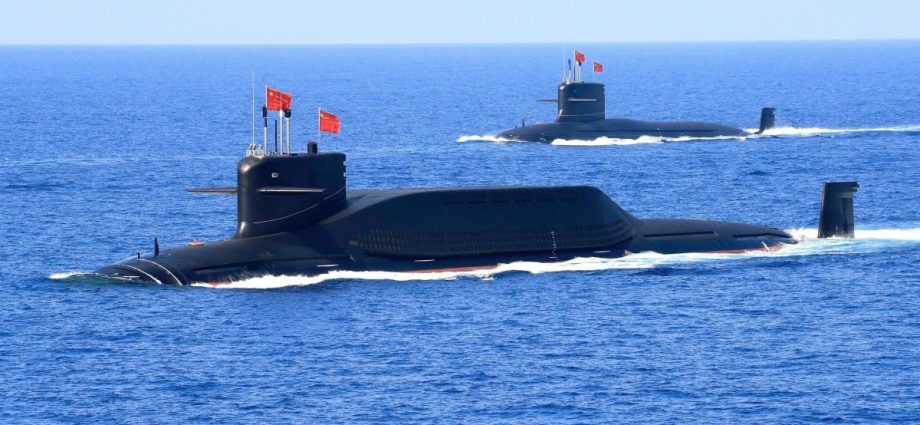Japan has revealed an innovative submarine design featuring vertical launch systems (VLS), signaling a strategic shift in the nation’s naval warfare approach amid escalating regional tensions.
Kawasaki Heavy Industries (KHI), a leading Japanese defense company, unveiled the new VLS submarine concept for the Japan Maritime Self-Defense Force (JMSDF), Naval News reported this month.
The report says the VLS is likely fitted between the submarine’s sail and bow and is driven by a diesel-electric propulsion system. It also says the submarine has aft-positioned sails and bow-diving planes, emphasizing increased maneuverability.
The new submarine will replace Japan’s Taigei class, the latest submarine class in the JMSDF’s fleet. KHI is also participating in a study with the Japanese Ministry of Defense on loading standoff missiles on submarines.
Naval News says the JMSDF’s future submarines will feature high stealth technology, high detection capability, improved maneuverability and carbon dioxide removal technology. The report says this may be in anticipation of future changes in JMSDF submarine operations.
Naval News notes there has been a proliferation of SLBM-capable submarines and an increasing trend of standoff missiles. It says that loading standoff missiles on submarines will change their passive operations to active and embed them within the integrated firepower supporting the JMSDF’s cross-domain operations.
Japan has embarked on a significant submarine program to bolster its capabilities to match China’s growing submarine fleet and to better monitor North Korea’s submarine movements.
Japan’s 2023 Defense White Paper notes that China’s submarine fleet grew from 40 units in 2013 to 57 in 2022. Chinese submarines may have also infiltrated Japanese waters, with Reuters reporting in September 2021 that the JMSDF identified an alleged Chinese submarine and a destroyer outside territorial waters off Amani Island.
Submarine intrusions are a critical threat for Japan, an island nation vulnerable to a naval blockade. Japan’s submarines are also crucial in securing the waters around the Ryukyu Islands.

The Ryukyu Islands are a critical maritime chokepoint for China to reach the Pacific Ocean’s open waters to perform flanking maneuvers from the north against Taiwan or to get its nuclear ballistic submarines (SSBN) with older JL-2 submarine-launched ballistic missiles (SLBM) within striking range of the US mainland.
In a February 2021 article for the Foreign Policy Research Institute (FPRI), Felix Chang notes that Japan’s naval strategy exploits the strategic location of the Ryukyu Islands to establish chokepoints to limit China’s freedom of action.
Chang notes that the 250-kilometer-wide Miyako Strait is especially critical since, besides submarine infiltrations, China has conducted large-scale naval exercises in the area, simulating how to support a contested transit.
He mentions that Japan has begun to deploy anti-ship missile batteries, underwater sensors and surface-to-air-missiles (SAM) on the Ryukyus to repel a possible Chinese incursion.
In addition to those defenses, Chang notes that even in peacetime Japanese submarines probably patrol the western approaches to the Ryukyu Islands, aiming to intercept Chinese submarines and ships attempting to slip past.
Japan’s 2023 Defense White Paper says Japan has in recent years increased its submarine fleet from 16 to 22, with Chang noting that Japan’s increasingly advanced submarines, such as the Taigei class, could even strike at Chinese forces as they sailed northward from the South China Sea.
However, Japan’s next-generation VLS submarines may hint at efforts to increase the survivability of its counterstrike capabilities built on amassing a substantial arsenal of long-range missiles.
Chang notes that China could target Japan’s anti-ship missile batteries in the Ryukyu Islands, blinding radars with electronic warfare attacks, destroy missile launchers and storage facilities with cruise missile strikes, and fend off Japanese fighter aircraft. Once those objectives have been accomplished, Chang notes that Chinese forces could safely traverse the Miyako Strait.
More tellingly, a 2017 Breaking Defense article mentions that a massive Chinese pre-emptive missile strike on Japan could take out US and Japanese warships at port and aircraft on the ground.
Breaking Defense says that China has enough munitions to hit 500 critical targets in Japan such as naval and air bases, command posts, communications hubs, fuel tanks and other military-essential infrastructure.
The source also notes that China’s 1,200 short-range ballistic missiles (SRBM) can hit Okinawa and that its 200 to 300 medium-range ballistic missiles (MRBM) can hit any point in Japan, with both SRBMs and MRBMs hitting their targets within 15 minutes after launch.
It also says that conventional bombers and ground-launched cruise missiles would follow a pre-emptive missile strike to destroy whatever the first missile strikes missed. It says that a follow-up strike could use munitions with penetrating warheads to blast open bunkers and cratering warheads to punch holes in runways, trapping aircraft on the ground.

Given that scenario, it makes strategic sense for Japan to have sea-based conventional counterstrike capabilities that could survive a pre-emptive missile attack and maintain a credible deterrent.
In an April 2023 article for nippon.com, Tanida Kuniichi mentions that introducing VLS-equipped submarines with long-range missiles, such as the US-made Tomahawk with a 1,600-kilometer range, marks a significant shift in Japan’s submarine doctrine.
Kuniichi notes that Japan’s submarines were previously limited to ship attacks, minelaying and intelligence gathering. He says that VLS-equipped submarines would allow Japan to exploit the unique characteristics of submarines for offensive operations, employing “shoot and scoot” tactics when launching missiles against inland targets in China and also North Korea.
However, Kuniichi points out that while Japan can increase the number of VLS submarines in its fleet, its ambitions may be hampered by a lack of skilled personnel. He notes that the Japan Self-Defense Forces JSDF is facing a recruitment problem, with a relatively early retirement age and Japan’s low birthrate and aging population undermining its defense plans.

